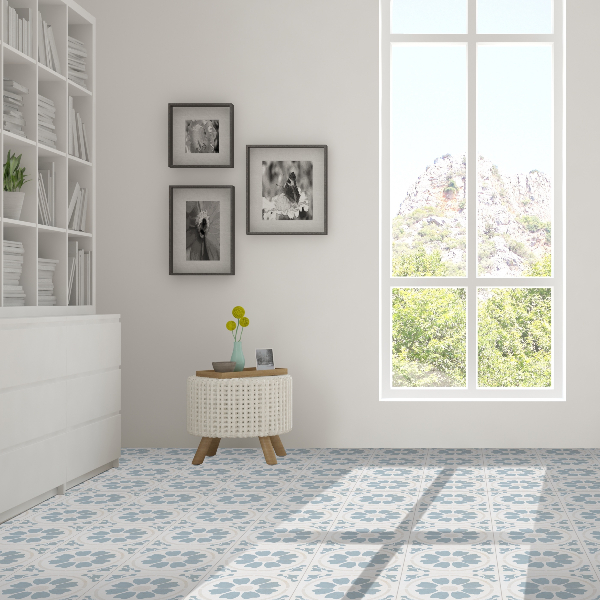Porcelain Tile Or Ceramic Tile: Which Is Best For Floor Tile?
September 17, 2021
Tile has been a popular choice for flooring for a long time, and today’s products are better than ever with a huge selection of colors and patterns. From traditional square or rectangular tiles in solid colors or geometrics to incredibly authentic natural stone or wood lookalikes, it’s easy to get the look you want with little care and maintenance. But when faced with the choice between ceramic and porcelain tile, it’s important to know the pros and cons of each so you can select the perfect tile for your home.
At first glance, porcelain and ceramic tiles may seem very similar — there are a few key differences, however. Both types of tile are manufactured from clay and baked in a kiln. A decorative pattern is applied, and then a protective glaze covers it all.
Differences between ceramic and porcelain tile include the type of clay used, the curing process, and the coatings. It’s not fair to say that one type of tile is better than the other, whether it’s going to be used for floor tile, wall tile, or some other purpose. Your choice depends upon the location where you want to install it, mainly because porcelain tile is more water-resistant than ceramic.

Ceramic tile is manufactured with red, yellow, or white clay. Traditionally, ceramic tiles were made by hand, pressed into a mold, and left to dry in the sun or a kiln. Today’s modern tile is made with a press, then glazed and fired in a high-temperature kiln reaching 1,650 degrees Fahrenheit. If an elaborate pattern or many colors are desired, the ceramic tile may be fired more than once.
Porcelain tile is manufactured with a purer, finer-textured clay that may contain additives to further enhance its hardness and durability. The manufacturing process is similar, but they are fired at a much higher temperature, which may reach 2,500 degrees Fahrenheit. The combination of special clay, higher pressure, and higher temperatures creates a tile that is harder, denser, and less permeable.
Here are some of the major differences between these two types of tile flooring options, which will influence your choice.
Appearance and Style
Most ceramic tile is either a solid color or decorated with a simple geometric pattern. Ceramic tile is also manufactured in bold, colorful, artisan-inspired patterns, but it’s typically intended for use on the wall, such as backsplash tile, instead of flooring. Porcelain tile, on the other hand, is manufactured to resemble a nearly infinite variety of other materials such as solid hardwood, natural marble, travertine, and more. The process of inkjet printing allows homeowners to enjoy the look of these natural materials, which can be high-maintenance, without the worry and the work.
Both porcelain and ceramic tile can be installed in a variety of patterns, which dramatically expands the possibilities for creating a unique look. Check out MSI’s Floor Pattern Tool to compare popular tile patterns for a variety of sizes and shapes.

Water Resistance
The glaze on ceramic floor tile makes it water-resistant and therefore appropriate for use as floor tile. Porcelain tile flooring, however, is much denser and totally water-resistant without the need for sealing. This makes porcelain tile a better choice for rooms that frequently have wet floors or potential spills, such as kitchens, bathrooms, laundry rooms, and mudrooms. Porcelain tile is even appropriate for outdoor use, such as patios or pool decks.
Durability
Ceramic tiles are less dense than porcelain and are therefore more prone to chipping and cracking. Also, since the color of the clay underneath the tile’s glaze may be very different, it’s more likely to show chips or worn spots than porcelain tile. Porcelain is the better choice for high traffic areas.
Installation
Both types of tile have the same process for installation. After preparing the underlayment or subfloor, tiles are adhered with a thinset mortar adhesive with spacers between each tile. After the tiles are set, the spaces between the tiles are filled with mortar-based grout. A sealer is recommended for the grout lines to make it fully water- and stain-resistant.
The difference between the two types of tile is how they are cut to fit the room or to fit around obstacles such as fixtures, vents, or pipes. Ceramic tile is easy to cut with an inexpensive snap tile cutter or glass cutter. Since porcelain tile is denser and harder, a wet tile saw with a diamond blade is recommended. It is also more brittle, so cutting it may be tricky.
If you intend to install the flooring yourself, ceramic tile is by far the better choice — especially for those who don’t want to rent or invest in specialized equipment or don’t have a lot of experience with tile. If you choose to install porcelain, hiring an experienced contractor may provide better results.
Cost
Porcelain tile is typically more expensive than ceramic tile, although both have a wide range of price points depending upon the quality, size, pattern, glazing, and location of manufacture. Also, since porcelain tile is not recommended for money-saving DIY projects, you’ll need to factor in the cost of hiring a professional installer.
There is no easy answer to the question of which type of tile is better for your home’s flooring; it depends on many things. You’ll need to consider the room in which you will install it, the finished look you’re aiming for, and the type of project you have in mind — whether it will be a DIY project or you’re hiring a pro to do the job. No matter which you choose, MSI offers a wide selection of top-quality ceramic and porcelain tiles, so you’re sure to find the perfect tiles for your home.
READ MORE ABOUT THE DIFFERENCES BETWEEN PORCELAIN AND CERAMIC TILE
Porcelain Tile That Looks Like Slate Vs. Real Slate Tile
What's The Difference? Porcelain Tile vs. Ceramic Tile
Porcelain Tile Vs. Ceramic Tile For Heavy Traffic Walkways
